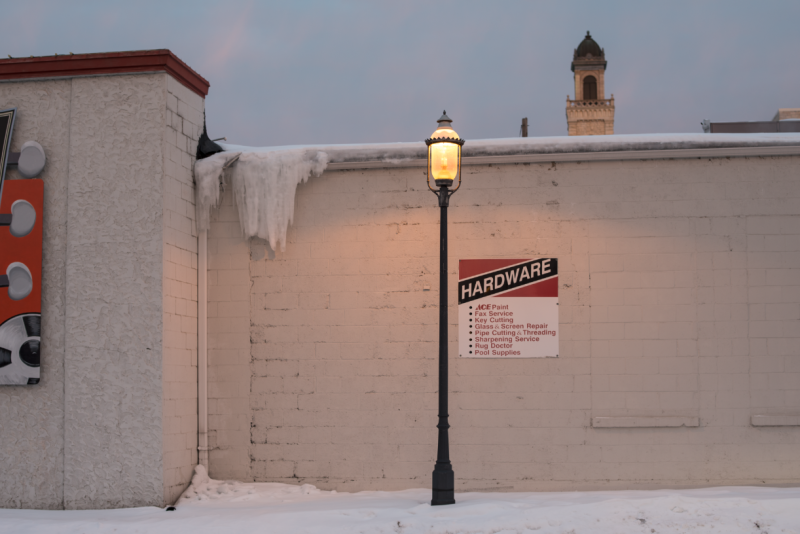"In the same way that the transition from film to digital is now taken for granted, the shift from cameras to networked devices with lenses should be obvious...you realize that there is a compelling universe of information waiting to be pinned to the back of each image. Once you start thinking of a photograph in those holistic terms, the data quality of stand-alone cameras, no matter how vast their bounty of pixels, seems strangely impoverished. They no longer capture the whole picture."
—From "Goodbye, Cameras," by Craig Mod
at The New Yorker blog, December 31, 2013
When I first read this article, my response was an eye-roll: as you've probably noticed, "cameras are gonna die," sky-is-falling, smartphones-are-taking-over type articles are in fashion at the moment in the land of Journalist-iness, and already a cliché.
But this conclusion really did make me think. Not so much about current "connectedness"—in general I'm the type of person who aspires to be less connected, not more—as about spheres of communication in general. My preferred means of communication is email, and I get out of touch with friends and relatives who don't like it or seldom use it. I have a few friends who are into Twitter (hey, Barb H.) and one or two who live at Facebook (hi, Art and Mari). Our spheres don't overlap much. I don't understand why they don't just send emails like normal humans and they don't understand why I don't follow them or check my Facebook board (or whatever it's called—I don't speak Facebook). People (largely, businesses) who still communicate by land-line phones get frustrated with me in the same way (being a writer, I often have my phone turned off).
Then I started thinking about what he was saying in dawn-of-digital terms. I have only a small amount of my film work digitized (most of it scanned to use as illustrations for my longtime column, now ended, in Black & White Photography magazine). I seldom share much of it even here on TOP. Don't even own a scanner any more (I have ludicrous bad luck with scanners, but that's an amusing tale for another day). I realize now that I always considered that situation temporary. I'm starting to realize it's not.
I've only slowly separated myself from my long-held belief that it's prints that matter, everything else being a poor substitute or a stopgap or shorthand. But I myself have been communicating on the Internet/Web for a decade now; it's already a more permanent situation than I once thought it was. Even for me, despite my reflexive print-primacy.
This is why I came very close to picking the Sony RX10 as the "Camera of the Year." It's a perfect all-in-one camera for people who make videos and pictures and share them in electronic form exclusively—whose bulletin board is flickr, who share via blogs and texts and whatnot, and whose "art gallery" is a tablet with a high-res screen. A 1-inch sensor might be small format for prints, but it's large format for the Web and digital display, where the norm is closer to <6x4mm sensors like the one in my iPhone 4s.
That's viable now. My point is that I don't even have to look to next-gen connectedness to decipher his argument. My film work in print form is never going to see the Internet and the World Wide Web...and it's not going to see much else, either. The inescapable conclusion is that it doesn't even matter, or even that it might as well not exist, and the reason is—pace Craig Mod's article—that it's not connected. It's like it's in a different language (a legacy ethnic language, like, say, Gaelic, or Hopi), awaiting translation. And it's going to remain invisible until that happens.
Mike
(Thanks to Dave Sailer)
Original contents copyright 2014 by Michael C. Johnston and/or the bylined author. All Rights Reserved. Links in this post may be to our affiliates; sales through affiliate links may benefit this site.
TOP's links!
(To see all the comments, click on the "Comments" link below.)
Featured Comments from:
Jay Pastelak: "As a teacher of now digital photography who came up in the 1970s, I know exactly what you mean. I teach digital printing and keep asking 'Why?' when most of what my students produce will most likely be presented in a digital format. I still think a well-crafted print is a thing of value, but eventually printing may become an arcane craft, like the caning of chair seats or umbrella repair.
"In his book After Photography, Fred Ritchin describes this totally interconnected universe where software searches the web and can construct a photo of, say, the Eiffel Tower by finding and stitching together all the available photos of the landmark. He suggests that tourists will be able to create their own snapshots, including themselves, by this kind of stitching, putting themselves before the Eiffel Tower before they go to Paris. The concept lends itself to absurdist theater, making tourist snapshots of landmarks one hasn't actually visited, but it's probably in the future.
"Suddenly photographs, which we have assumed told some kind of objective truth, can become less and less truthful. Weird and scary."
rnewman: "The problem with the 'Goodbye, Cameras' position is that it assumes the camera cannot and will not be 'connectable.' In fact cameras today already provide Internet connectivity and audio (usually with video), and connecting an audio clip to a still photo is not a great technical leap. It probably is easiest done by attaching to the XML file, or by.... If you don't mind hunt and peck texting, that too could be made available if there is demand. I won't demand—I hate talking with my thumbs. I much prefer leaving voice messages to text ones. My take is that we will see cameras evolve into more connected devices, just as smartphones and tablets have, but the demand for better quality images will still be there. So cameras will evolve, but not disappear."
psu (partial comment): "I found this article frustrating because while it had some genuine insight it also completely misses the big picture in order to attach itself to what it sees at the larger social and technical trends in the industry. What does it miss? It misses this: the tools you use are very dependent on how you plan to deliver the pictures, not how you shoot them in the first place. Now, it's true that most people these days deliver pictures digitally, and for this having a camera that is on the Internets has some value. It's also true that the traditional camera companies have completely missed the boat on this functionality, which is a big reason why phone cameras are killing in the low to mid end. The New Yorker piece starts with the premise that people want to share pictures over the Internet and ends with 'and phones do that, so cameras are dead.'
[...]
"I think the New Yorker piece ultimately misses the point because it is ignoring anyone who does not use the prevailing mass-market photo workflow. I don't mean to put myself, or anyone else, on a higher plane than the masses just sending out pictures with Twitter. I'm in general not one who thinks that the new ways of working inherently cheapen the medium or anything, or that you have to shoot RAW and painstakingly edit in Photoshop in order to do 'real work.' I'm just saying that the tools you want are determined by how you work, and I think this piece misses that."
[For psu's complete comment, please see the Comments Section. —Ed.]
Jamie: "I notice that none of the above commenters, including Thom, mention Fuji. Thoughts? They seem to be going down a different road, as Sony is."
Thom replies to Jamie: "Fujifilm and Ricoh (Pentax) are two very interesting examples. To use a term that Steve Jobs seems to have made popular, digital cameras to those companies are 'hobby businesses.' In neither case are digital cameras a large enough part of the overall company to alter the overall business results at the moment. One analyst said to me that he regards the camera operations finances at Ricoh as a 'rounding error.'
"In that sense, both those companies can continue to lose money at camera production as long as management wants to tolerate it. Fujifilm recently disclosed that they sold a grand total of 700,000 X cameras in a bit over two years. That includes more than a half dozen models, all of which have gotten more press than they've gotten sales, apparently.
"My guess is that both Fujifilm and Ricoh (Pentax) will continue to iterate cameras until the bitter end, but also be slowly downsizing their operations, as well.
"Back at the turn of the century when I talked with executives at virtually any consumer electronics company, the prevailing attitude was that digital cameras were a double-digit growth bet ad infinitum. Everyone wanted to be in the business. At one point, I counted 64 producers of compact digital cameras because of that. Despite the 61 other entrants, the long-term oligopoly of Canikony [Canon, Nikon, and Sony —Ed.] still retained a majority of the market (though barely at one point), which made a lot of those operations unprofitable (witness Kodak and HP). Slowly, the companies governed by Western accounting standards all ended up out of the business, while the Asian ones tended to consolidate (e.g., Panasonic bought Sanyo).
"The market will likely collapse enough that we'll see a short return of growth, followed by either another decline, flatness, or some disrupting technology reigniting the market.
"I should point out that smartphones will eventually do the same thing as compact cameras. The huge growth days are already tapering. We're entering a smartphone market that's going to be driven more by replacement than new users. We'll eventually get to the point where replacement is tough to do because the product you have is 'good enough.'
"The tech marketplace is broken into basically two groups: the leaders who push disruption, and the chasers, who try to grab share in any new market that develops and ride the tide upwards."
Jim Richardson: "Recently I have realized that the pictures I take with my iPhone are often more useful than the pictures I take with my Nikon. I can immediately put them to work. Nikon and Canon have spent a lot of time and research making their cameras more functional. They need to start making the pictures more functional."
[Jim is a National Geographic photographer. —Ed.]





